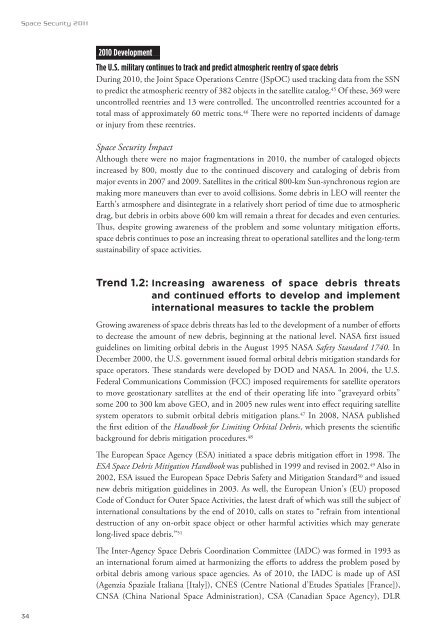Space Security Index
Space Security Index
Space Security Index
You also want an ePaper? Increase the reach of your titles
YUMPU automatically turns print PDFs into web optimized ePapers that Google loves.
<strong>Space</strong> <strong>Security</strong> 2011<br />
34<br />
2010 Development<br />
The U.S. military continues to track and predict atmospheric reentry of space debris<br />
During 2010, the Joint <strong>Space</strong> Operations Centre (JSpOC) used tracking data from the SSN<br />
to predict the atmospheric reentry of 382 objects in the satellite catalog. 45 Of these, 369 were<br />
uncontrolled reentries and 13 were controlled. e uncontrolled reentries accounted for a<br />
total mass of approximately 60 metric tons. 46 ere were no reported incidents of damage<br />
or injury from these reentries.<br />
<strong>Space</strong> <strong>Security</strong> Impact<br />
Although there were no major fragmentations in 2010, the number of cataloged objects<br />
increased by 800, mostly due to the continued discovery and cataloging of debris from<br />
major events in 2007 and 2009. Satellites in the critical 800-km Sun-synchronous region are<br />
making more maneuvers than ever to avoid collisions. Some debris in LEO will reenter the<br />
Earth’s atmosphere and disintegrate in a relatively short period of time due to atmospheric<br />
drag, but debris in orbits above 600 km will remain a threat for decades and even centuries.<br />
us, despite growing awareness of the problem and some voluntary mitigation eorts,<br />
space debris continues to pose an increasing threat to operational satellites and the long-term<br />
sustainability of space activities.<br />
Trend 1.2: Increasing awareness of space debris threats<br />
and continued eorts to develop and implement<br />
international measures to tackle the problem<br />
Growing awareness of space debris threats has led to the development of a number of eorts<br />
to decrease the amount of new debris, beginning at the national level. NASA rst issued<br />
guidelines on limiting orbital debris in the August 1995 NASA Safety Standard 1740. In<br />
December 2000, the U.S. government issued formal orbital debris mitigation standards for<br />
space operators. ese standards were developed by DOD and NASA. In 2004, the U.S.<br />
Federal Communications Commission (FCC) imposed requirements for satellite operators<br />
to move geostationary satellites at the end of their operating life into “graveyard orbits”<br />
some 200 to 300 km above GEO, and in 2005 new rules went into eect requiring satellite<br />
system operators to submit orbital debris mitigation plans. 47 In 2008, NASA published<br />
the rst edition of the Handbook for Limiting Orbital Debris, which presents the scientic<br />
background for debris mitigation procedures. 48<br />
e European <strong>Space</strong> Agency (ESA) initiated a space debris mitigation eort in 1998. e<br />
ESA <strong>Space</strong> Debris Mitigation Handbook was published in 1999 and revised in 2002. 49 Also in<br />
2002, ESA issued the European <strong>Space</strong> Debris Safety and Mitigation Standard 50 and issued<br />
new debris mitigation guidelines in 2003. As well, the European Union’s (EU) proposed<br />
Code of Conduct for Outer <strong>Space</strong> Activities, the latest draft of which was still the subject of<br />
international consultations by the end of 2010, calls on states to “refrain from intentional<br />
destruction of any on-orbit space object or other harmful activities which may generate<br />
long-lived space debris.” 51<br />
e Inter-Agency <strong>Space</strong> Debris Coordination Committee (IADC) was formed in 1993 as<br />
an international forum aimed at harmonizing the eorts to address the problem posed by<br />
orbital debris among various space agencies. As of 2010, the IADC is made up of ASI<br />
(Agenzia Spaziale Italiana [Italy]), CNES (Centre National d’Etudes Spatiales [France]),<br />
CNSA (China National <strong>Space</strong> Administration), CSA (Canadian <strong>Space</strong> Agency), DLR

















